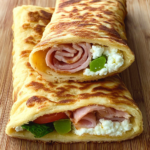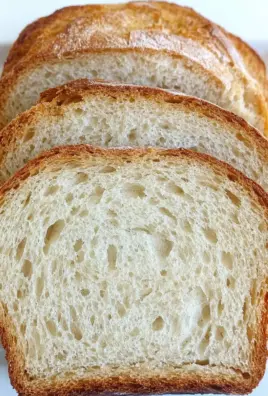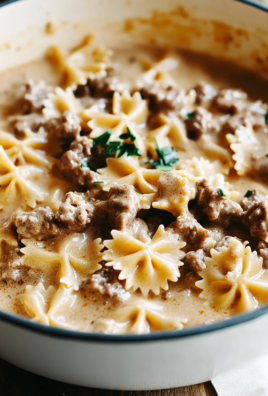If you’re looking for a high-protein, low-carb alternative to traditional flatbreads, this cottage cheese flatbread is the perfect recipe to try. With just two primary ingredients plus some optional seasonings, this recipe delivers a flexible, soft flatbread that’s perfect for wraps, pizzas, or dipping into your favorite spreads.
Whether you’re following a low-carb, gluten-free, or high-protein diet, this recipe offers a nutritious option that’s light yet satisfying. Its minimal ingredient list, simple preparation, and versatility make it a great addition to your meal prep rotation.
What sets cottage cheese flatbread apart is its balance between ease and nutrition. Cottage cheese provides a rich source of protein, essential for muscle support and satiety, while eggs contribute to the flatbread’s structure and flexibility. The result is a soft, pliable flatbread that can be enjoyed on its own or as part of a larger meal.

Why You’ll Love This Recipe
- High Protein and Low Carb – Ideal for fitness enthusiasts, those watching carbs, or anyone seeking a high-protein snack.
- Naturally Gluten-Free – No flour, making it a suitable choice for those with gluten sensitivities.
- Simple Ingredients – You probably already have everything you need.
- Incredibly Versatile – Use it for pizzas, wraps, sandwiches, or as a side for soups and salads.
- Quick to Make – Ready in about 35 minutes, including baking time.
- Flexible Texture – Soft enough for wraps, sturdy enough for pizza crust.
Preparation Phase and Essential Tools
To get the perfect cottage cheese flatbread, it’s important to prepare your ingredients and tools properly. A smooth batter is key to a uniform texture, and the right equipment ensures even baking and easy handling.
Essential Tools and Their Importance
- Blender or Food Processor – Blending the cottage cheese and eggs creates a smooth, even batter without lumps.
- Baking Sheet – Provides a large, flat surface for even cooking.
- Parchment Paper – Prevents sticking and ensures easy removal after baking.
- Non-Stick Spray – Adds extra insurance against sticking.
- Spatula – Helps spread the batter into an even layer.
- Cooling Rack – Allows airflow to prevent sogginess while the flatbread cools.
Ingredients List
- 1 cup cottage cheese (drained of excess liquid)
- 2 large eggs
- ¼ teaspoon garlic powder (optional for flavor)
- ½ teaspoon Italian seasoning (or your favorite dried herb blend)
Optional Additions
- Finely grated parmesan for extra cheesiness
- Everything bagel seasoning sprinkled on top before baking
- Chopped fresh herbs like parsley or chives
Step-by-Step Instructions
1. Blend the Batter
Add the cottage cheese, eggs, garlic powder, and Italian seasoning into a blender or small food processor. Blend for about 30 to 45 seconds, or until the mixture is completely smooth. This step is essential for ensuring the flatbread has a uniform texture without lumps.
2. Prepare the Pan
Line a baking sheet with parchment paper and lightly spray it with non-stick spray. This prevents sticking and makes the flatbread easier to remove after baking.
3. Spread the Batter
Pour the batter onto the prepared baking sheet. Use a spatula to spread it evenly into a rectangle, aiming for about ⅜ to ½ inch thick. Spreading it too thin may cause it to crisp too much, while spreading it too thick could leave it undercooked.
4. Bake
Preheat your oven to 350°F. Place the baking sheet in the oven and bake for approximately 30 minutes, or until the edges are golden brown and the flatbread is firm to the touch. Rotate the pan halfway through baking for even cooking.
5. Cool and Serve
Remove the flatbread from the oven and allow it to cool completely on a cooling rack. This step is important for ensuring the flatbread becomes pliable and easy to slice or roll. Once cooled, cut it into portions or use it as a base for pizza, wraps, or sandwiches.
Pro Tips for Perfect Flatbread
- Drain the cottage cheese well to prevent a watery batter.
- Use room temperature eggs for smoother blending.
- Check the edges during baking—if they start to over-brown, tent the flatbread lightly with foil.
- Let the flatbread cool fully before slicing to help it firm up.
Serving Suggestions for Cottage Cheese Flatbread
One of the best things about cottage cheese flatbread is its versatility. Whether you want a quick snack, a light meal, or a flexible wrap option, this high-protein flatbread can do it all. Its mild flavor works with a wide range of toppings, from Mediterranean spreads to fresh vegetables and proteins. Below are some of the best ways to serve this flatbread.
As a Pizza Base
Use cottage cheese flatbread as a low-carb pizza crust. After the flatbread cools, top it with marinara, mozzarella, and your favorite vegetables or proteins. Bake briefly to melt the cheese.
Wraps and Sandwiches
This flatbread has just enough flexibility to act as a wrap. Fill it with sliced grilled chicken, avocado, and greens for a satisfying lunch. For a vegetarian option, try hummus, roasted vegetables, and feta cheese.
Appetizer Pinwheels
Spread herbed cream cheese across the flatbread, layer with smoked salmon or turkey, then roll and slice into pinwheels for a healthy appetizer.
Dipper for Soups and Spreads
Cut the flatbread into strips and serve it with creamy dips like tzatziki, hummus, or guacamole. It also pairs well with tomato basil soup for a comforting lunch.
Breakfast Option
Top the flatbread with scrambled eggs, avocado, and hot sauce for a protein-packed breakfast. You can also drizzle it with almond butter and fresh berries for a sweet variation.
Mediterranean Mezze Platter
Use the flatbread as part of a Mediterranean spread with grilled vegetables, olives, roasted red peppers, and baba ghanoush.
Sweet Flatbread Treat
Although this recipe leans savory, you can tweak it with a touch of cinnamon and vanilla in the batter. Once baked, spread with Greek yogurt, honey, and fruit for a light dessert.
Side Dish Recommendations
Pairing cottage cheese flatbread with complementary sides rounds out your meal. Below are eight side dishes that work well with the mild, cheesy flavor of this flatbread.
- Greek Salad – Crisp cucumbers, tomatoes, red onions, olives, and feta with lemon dressing.
- Roasted Garlic Hummus – Creamy hummus adds flavor and protein.
- Lemon Herb Quinoa Salad – Light, tangy, and full of fresh herbs.
- Creamy Tomato Basil Soup – A comforting classic that pairs well with cheesy flatbread.
- Balsamic Grilled Vegetables – Zucchini, peppers, and eggplant with a sweet tangy glaze.
- Cucumber Yogurt Dip – Cool, creamy, and refreshing.
- Spinach Strawberry Salad – Sweet and savory balance with nuts and feta.
- Roasted Red Pepper Walnut Spread – A bold, creamy dip with Mediterranean flair.
Common Mistakes and How to Avoid Them
Even though this recipe is simple, a few common mistakes can affect the outcome. Below are the most frequent issues home cooks encounter when making cottage cheese flatbread, along with practical tips to avoid them.
1. Batter is Too Runny
Cause: Failing to drain the cottage cheese thoroughly.
Solution: Drain the cottage cheese using a fine mesh sieve or cheesecloth to remove excess liquid before blending.
2. Flatbread Sticks to Parchment
Cause: Insufficient greasing or low-quality parchment paper.
Solution: Use high-quality parchment paper and lightly spray it with non-stick cooking spray before adding the batter.
3. Uneven Thickness
Cause: Spreading the batter inconsistently.
Solution: Use an offset spatula to ensure an even layer across the pan. Keep the thickness between ⅜ and ½ inch for best results.
4. Overly Crispy Edges
Cause: Spreading the batter too thin at the edges.
Solution: Keep the batter thickness consistent and avoid tapering at the edges.
5. Undercooked Center
Cause: Batter spread too thick or oven temperature is uneven.
Solution: Bake at 350°F and check for golden edges. Rotate the pan halfway through to ensure even baking.
6. Flatbread Breaks When Rolling
Cause: Cutting or rolling the flatbread before it cools completely.
Solution: Let the flatbread cool fully to allow it to firm up before slicing or rolling.
7. Bland Flavor
Cause: Not enough seasoning in the batter.
Solution: Don’t skip the garlic powder and Italian seasoning, or experiment with additional herbs and spices to match your personal tastes.
8. Overbaking
Cause: Leaving the flatbread in the oven too long.
Solution: Check at the 25-minute mark. It should be firm but not dry, with lightly golden edges.
Additional Recipe Tips for Perfect Cottage Cheese Flatbread
While cottage cheese flatbread is simple to prepare, a few expert tips can make the process smoother and help you achieve consistently great results.
Use Full-Fat Cottage Cheese
Full-fat cottage cheese tends to have a richer flavor and better texture than low-fat versions. If you want the best possible taste and flexibility, full-fat is worth considering.
Drain Excess Liquid
Cottage cheese often contains more liquid than needed for this recipe. For a sturdier flatbread, drain the cottage cheese thoroughly using a fine-mesh sieve or cheesecloth. This step is crucial to prevent a runny batter and ensure even baking.
Experiment with Seasonings
While the recipe calls for Italian seasoning and garlic powder, you can adjust the flavor profile to suit your meal. For a Mediterranean twist, add oregano and dried basil. For a spicy kick, try smoked paprika and crushed red pepper flakes.
Monitor Oven Hot Spots
Every oven is different. Rotate the baking sheet halfway through to ensure the flatbread bakes evenly. If your oven tends to run hot, consider reducing the temperature slightly and extending the baking time.
Customize the Shape
For a more uniform result, you can use a silicone baking mat with guides, or even shape the batter into individual rounds for personal-sized flatbreads. This can be useful if you’re planning to use them for sandwiches or mini pizzas.
Storage Instructions
Refrigerating Cottage Cheese Flatbread
This flatbread keeps well for a couple of days if stored properly. Place it in an airtight container with parchment paper between layers to prevent sticking. Store in the refrigerator for up to 2 days.
Freezing Instructions
If you want to make cottage cheese flatbread in bulk, freezing is an option. After baking and cooling, slice the flatbread into portions, wrap them individually in plastic wrap, and place them in a freezer-safe bag. Store for up to 1 month.
Reheating Tips
To reheat, use an oven or air fryer at 350°F for 5 to 7 minutes. This helps restore the crisp edges. Avoid microwaving, which can make the flatbread rubbery.
Frequently Asked Questions (FAQs)
Can I make cottage cheese flatbread ahead of time?
Yes, you can make the flatbread in advance and store it in the fridge for 1 to 2 days. Reheat before serving for best texture.
Is cottage cheese flatbread gluten-free?
Yes, this recipe is completely gluten-free, making it a great option for those with gluten sensitivities or celiac disease.
Can I use flavored cottage cheese?
You can, but make sure to drain it thoroughly, as flavored versions often have extra liquid. Some savory flavors like garlic and herb or chive work particularly well.
Can I make a dairy-free version?
This recipe relies heavily on cottage cheese, so a true dairy-free version is challenging. You could experiment with tofu-based cheese alternatives, but the texture and flavor will change.
Can I freeze cottage cheese flatbread?
Yes, it freezes well if you wrap it tightly. For best results, freeze individual slices with parchment between layers to prevent sticking.
Why is my flatbread too wet?
Excess moisture likely came from the cottage cheese. Be sure to drain it thoroughly before blending.
Can I add toppings before baking?
Yes, but avoid wet ingredients like tomatoes that could make the flatbread soggy. Cheese, seeds, or dried herbs are good options.
Is cottage cheese flatbread keto-friendly?
Yes, this recipe is keto-friendly due to its low carb and high protein content. It works well in low-carb meal plans.
What dips pair well with this flatbread?
Hummus, guacamole, tzatziki, and roasted red pepper spread all complement the mild, cheesy flavor of the flatbread.
Can I double the recipe?
Absolutely. Use a larger baking sheet or divide the batter between two smaller pans. You may need to extend baking time slightly.
Conclusion
Cottage cheese flatbread offers a versatile, high-protein, and gluten-free alternative to traditional flatbreads. Whether you follow a low-carb diet, want a healthy option for wraps, or need a sturdy base for homemade pizza, this recipe covers all the bases. With just a few ingredients and minimal prep time, you can have a tasty, flexible flatbread ready to customize to your tastes.
The flexibility of this recipe makes it perfect for meal prep, allowing you to create everything from savory wraps to appetizer pinwheels and even low-carb snacks. With the right techniques, from draining your cottage cheese properly to spreading the batter evenly, you’ll have consistent results every time.
If you’re looking for an easy gluten-free flatbread that doesn’t sacrifice flavor or texture, this cottage cheese flatbread is a recipe you’ll want to keep on hand. It fits effortlessly into keto, gluten-free, and high-protein diets, proving that simple ingredients can still produce delicious, adaptable results.
Explore additional recipes featuring cottage cheese for even more healthy meal ideas. From cottage cheese pancakes to high-protein dips, there are countless ways to make this versatile ingredient shine.
Cottage Cheese Flatbread
Ingredients
- 1 cup cottage cheese drained of excess liquid
- 2 eggs
- ¼ teaspoon garlic powder
- ½ teaspoon Italian seasoning
Instructions
Prepare the Batter
- Add cottage cheese, eggs, garlic powder, and Italian seasoning to a blender or small food processor.
- Blend until smooth, about 30 seconds.
Prep the Pan
- Line a sheet pan with parchment paper and lightly spray with non-stick cooking spray.
- Pour the blended batter onto the pan and spread evenly to about ⅜ to ½ inch thick.
Bake
- Preheat the oven to 350°F.
- Bake for approximately 30 minutes, or until the flatbread is cooked through and the edges are golden brown.
- Remove from the oven and let cool completely before slicing or serving.




Leave a Comment